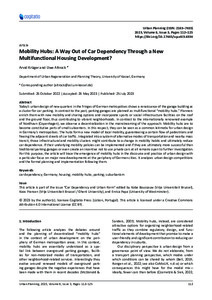Mobility Hubs: A Way Out of Car Dependency Through a New Multifunctional Housing Development?
| dc.date.accessioned | 2023-11-03T11:35:45Z | |
| dc.date.available | 2023-11-03T11:35:45Z | |
| dc.date.issued | 2023-07-25 | |
| dc.identifier | doi:10.17170/kobra-202311038951 | |
| dc.identifier.uri | http://hdl.handle.net/123456789/15147 | |
| dc.description.sponsorship | Gefördert durch den Publikationsfonds der Universität Kassel | |
| dc.language.iso | eng | |
| dc.rights | Namensnennung 4.0 International | * |
| dc.rights.uri | http://creativecommons.org/licenses/by/4.0/ | * |
| dc.subject | car dependency | eng |
| dc.subject | Germany | eng |
| dc.subject | housing | eng |
| dc.subject | mobility hubs | eng |
| dc.subject | parking | eng |
| dc.subject | suburbanism | eng |
| dc.subject.ddc | 710 | |
| dc.subject.ddc | 720 | |
| dc.title | Mobility Hubs: A Way Out of Car Dependency Through a New Multifunctional Housing Development? | eng |
| dc.type | Aufsatz | |
| dcterms.abstract | Today’s urban design of new quarters in the fringes of German metropolises shows a renaissance of the garage building as a cluster for car parking. In contrast to the past, parking garages are planned as multifunctional “mobility hubs.” Planners enrich them with new mobility and sharing options and incorporate sports or social infrastructure facilities on the roof and the ground floor, thus contributing to vibrant neighborhoods. In contrast to the internationally renowned example of Nordhavn (Copenhagen), we observe a decentralization in the mainstreaming of the approach: Mobility hubs are to become constitutive parts of small subcenters. In this respect, they can be seen as a common leitmotiv for urban design in Germany’s metropolises. The hubs form a new model of local mobility, guaranteeing a certain flow of pedestrians and freeing the adjacent streets of car traffic. Integrated into a system of alternative modes of transportation and nearby mass transit, those infrastructural and mobility clusters might contribute to a change in mobility habits and ultimately reduce car dependence. If their underlying mobility policies can be implemented and if they are ultimately more successful than traditional parking garages or even create an incentive not to use private cars at all remains open to further investigation. For this purpose, the article will trace the emergence of mobility hubs in the discourse and practice of urban design with a particular focus on major new developments at the periphery of German cities. It analyzes urban design competitions and the formal planning and implementation following them. | eng |
| dcterms.accessRights | open access | |
| dcterms.creator | Krüger, Arvid | |
| dcterms.creator | Altrock, Uwe | |
| dc.relation.doi | doi:10.17645/up.v8i3.6336 | |
| dc.subject.swd | Deutschland | ger |
| dc.subject.swd | Personenkraftwagen | ger |
| dc.subject.swd | Abhängigkeit | ger |
| dc.subject.swd | Raumordnung | ger |
| dc.subject.swd | Urbanität | ger |
| dc.subject.swd | Parken | ger |
| dc.subject.swd | Wohnen | ger |
| dc.subject.swd | Mobilität | ger |
| dc.subject.swd | Mobilitätszentrale | ger |
| dc.type.version | publishedVersion | |
| dcterms.source.identifier | eissn:2183-7635 | |
| dcterms.source.issue | Issue 3 | |
| dcterms.source.journal | Urban Planning | eng |
| dcterms.source.pageinfo | 112-125 | |
| dcterms.source.volume | Volume 8 | |
| kup.iskup | false |
Dateien zu dieser Ressource
Das Dokument erscheint in:
-
Artikel [1106]


